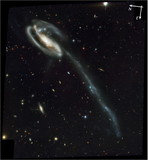Image Details

Caption: Fig. 14.
Comparison between HDFN spectroscopic and photometric redshifts obtained using basically the same filter set (B, V, I bands) as the VV 29 and NGC 4676 observations. Note that the axes are inverted with respect to the typical orientation in this kind of plot. This is done to better show the effects of using photometric redshifts to select galaxy samples. In the case of maximum‐likelihood photometric redshifts, almost one‐third of the ﹩z> 1.5﹩ objects would be misclassified low‐redshift objects, biasing high any estimate of the luminosity function, star formation rate, etc., obtained with them. The dashed line has slope 1, and it does not represent a fit to the data. The filled circles correspond to the objects classified as outliers in Table 3. Note that since the axis are inverted, the outliers were selected based on their horizontal distance to the dashed line with respect to the rms fluctuation.
Copyright and Terms & Conditions
© 2004. The American Astronomical Society. All rights reserved. Printed in U.S.A.












